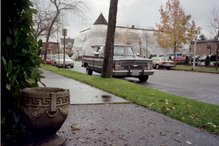JUNE 12th, 1930 - ÅBO (TURKU) FINLAND
Finland, hurray! At last we have reached our destination! Arriving in Åbo (boat and dock) about 8 A.M., we were all on pins and needles for fear that the customs officers would find something in our baggage which we shouldn't have. However, all they did was to open most of the suitcases and just hastily look into them. We had a great deal of waiting to do, because we were not to go to our hotel until about ten o'clock. The reperters were there the first thing when we got off the boat and took a picture of the choir for the papers. While waiting, we sat around on our suitcases on the dock, with the hot sun shining on us, and, as someone remaked, "we looked just like immigrants", which, of course, we were. We were immigrants from America, coming to Finland--some for the first time. I said goodbye to Edith, Taimi and Betty, hoping to see them again. Edith and Taimi were doing direct to Helsingfors and Betty was staying in Åbo.
After a great deal of talking, laughing, shouting, quarreling, etc. we were finally away to our hotel. We rode in a funny little short street car. The fare was about three cents in American money. We had been told that we were going to one of the best hotels in town, but if it was, the town hasn't many good hotels. The beds they had were all right, but they didn't have enough, and I had to sleep on two chairs.
(During the whole trip through Finland, Sweden, and Norway, I didn't once sleep in a real double bed or ever see one. All they have are cots or twin beds. In the hotels --at least most of them--they had two single beds rather than one double bed.)
That afternoon we went on a sight-seeing trip--walking! We walked up to an observatory and from that point you can see all over the town. We were also taken to the university, where we listed to another speech. Then to the glory of the day--the Dom Kyrka! It was wonderful! It is the biggest church I've ever been in, and it makes you feel so small when you are inside. This church is over 600 years old. The guide, who was on the entertainment committee, showed us all over the church and explained everything. We stood over the graves of bishops, pastors, clergymen, etc., saw many old statues, carvings and paintings, and listened to msuci from a beautifulpipe organ. Words can't express the beauty of that church.
After our interesing walk, we had dinner (And what a dinner!) at the Åbo Sang Forbunds Lokal, and then we looked in on the hall where the concert was to be. It was Brandkarshuset, and, in spite of the name, is a beautiful hall. After we got back to our hotel Mr. Carlson ordered us all to bed. We meekly obeyed and didn't wake up until 7 o'clock. The concert was to be at eight, and you can bet we hurried. As it was, we were just about late for our own concert. The concert went off grandly, with quite a few people in the audience, and twenty-nine as usual in the choir. Blanche sang--and the people "went wild" about her. She was obliged to sing three songs. There is something about Blanche's singing that "gets you". After the concert we were all entertained by the Åbo choir at a banquet. Here we were all mixed up--that is, we were all paired off with members of the Åbo choir--the ladies with men and vice versa. I had a good time with my man, and although I had quite a time getting started, I soon found myself talking quite fluently--with Ellis across the table to help me with the hard words. We all sang in chorus--the Finland chorus and the American chorus--and it was thrilling.
They also had the usual speeches and a short program. We had a bunch of the choir to see us back to our hotel, and I am sure we just about woke up the town.














